seats MAZDA MODEL CX-7 2007 (in English) User Guide
[x] Cancel search | Manufacturer: MAZDA, Model Year: 2007, Model line: MODEL CX-7, Model: MAZDA MODEL CX-7 2007Pages: 406, PDF Size: 6.11 MB
Page 21 of 406

Black plate (21,1)
NOTE
The seat temperature is regulated
automatically by a thermostat. Other
than turning it on or off, it cannot be
adjusted.
Rear Seat
WARNING
Do not stack cargo higher than the
seatbacks:
Stacking luggage or other cargo
higher than the seatbacks, and placing
articles on the rear seat is dangerous.
During sudden braking or a collision,
objects can fly around and become
projectiles that may hit and injure
passengers.
Make sure luggage and cargo is
secured before driving:
Not securing cargo while driving is
dangerous as it could move or be
crushed during sudden braking or a
collision and cause injury.
Make sure the adjustable components
of a seat are locked in place:
Adjustable seats that are not securely
locked are dangerous. In a sudden
stop or collision, the seat or seatback
could move, causing injury. Make sure
the adjustable components of the seat
are locked in place.
Essential Safety Equipment
Seats
2-9
CX-7_8V28-EA-06B_Edition2 Page21
Monday, March 13 2006 5:5 PM
Form No.8V28-EA-06B
Page 22 of 406
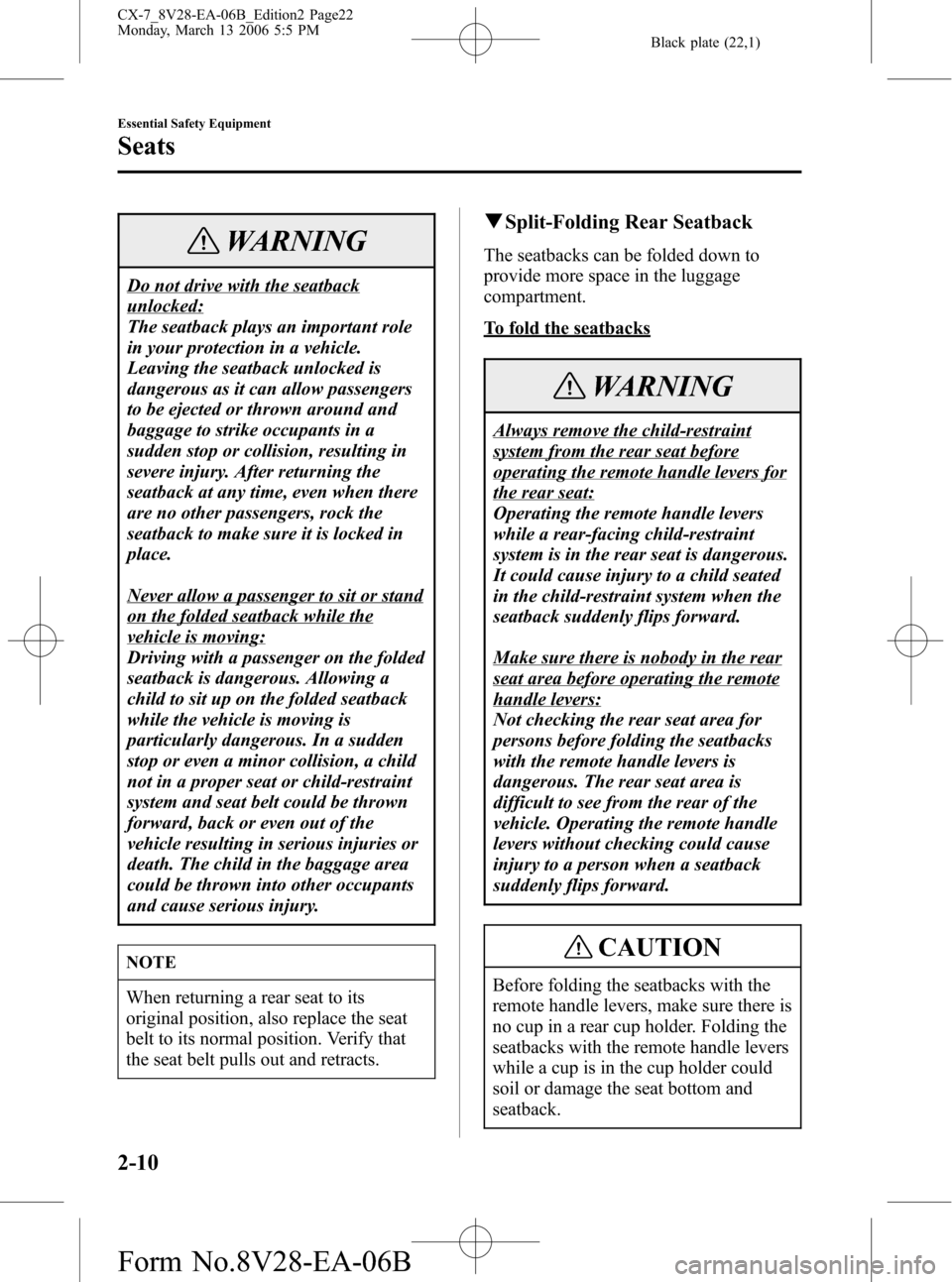
Black plate (22,1)
WARNING
Do not drive with the seatback
unlocked:
The seatback plays an important role
in your protection in a vehicle.
Leaving the seatback unlocked is
dangerous as it can allow passengers
to be ejected or thrown around and
baggage to strike occupants in a
sudden stop or collision, resulting in
severe injury. After returning the
seatback at any time, even when there
are no other passengers, rock the
seatback to make sure it is locked in
place.
Never allow a passenger to sit or stand
on the folded seatback while the
vehicle is moving:
Driving with a passenger on the folded
seatback is dangerous. Allowing a
child to sit up on the folded seatback
while the vehicle is moving is
particularly dangerous. In a sudden
stop or even a minor collision, a child
not in a proper seat or child-restraint
system and seat belt could be thrown
forward, back or even out of the
vehicle resulting in serious injuries or
death. The child in the baggage area
could be thrown into other occupants
and cause serious injury.
NOTE
When returning a rear seat to its
original position, also replace the seat
belt to its normal position. Verify that
the seat belt pulls out and retracts.
qSplit-Folding Rear Seatback
The seatbacks can be folded down to
provide more space in the luggage
compartment.
To fold the seatbacks
WARNING
Always remove the child-restraint
system from the rear seat before
operating the remote handle levers for
the rear seat:
Operating the remote handle levers
while a rear-facing child-restraint
system is in the rear seat is dangerous.
It could cause injury to a child seated
in the child-restraint system when the
seatback suddenly flips forward.
Make sure there is nobody in the rear
seat area before operating the remote
handle levers:
Not checking the rear seat area for
persons before folding the seatbacks
with the remote handle levers is
dangerous. The rear seat area is
difficult to see from the rear of the
vehicle. Operating the remote handle
levers without checking could cause
injury to a person when a seatback
suddenly flips forward.
CAUTION
Before folding the seatbacks with the
remote handle levers, make sure there is
no cup in a rear cup holder. Folding the
seatbacks with the remote handle levers
while a cup is in the cup holder could
soil or damage the seat bottom and
seatback.
2-10
Essential Safety Equipment
Seats
CX-7_8V28-EA-06B_Edition2 Page22
Monday, March 13 2006 5:5 PM
Form No.8V28-EA-06B
Page 23 of 406

Black plate (23,1)
When using the remote handle levers:
CAUTION
Be careful of the following when using
the remote handle levers:
lOn a downward slope, the seatback
could flip forward faster than on a
flat area.
lOn an upward slope, the seatback
may not fold down. When the
seatbacks cannot be folded down
with levers, pull the rear seatback
forward from inside the vehicle.
1. Unfasten the lap portion of the center-
rear seat belt (page 2-21).
CAUTION
Always unfasten the lap portion of the
belt before folding left-rear seatback.
Leaving the lap portion of the belt
fastened could cause damage to the seat
belt, buckle and seatback.2. After checking that the rear seats are
clear, open the liftgate compartment
and pull the remote handle levers on
the left and right side of the liftgate
compartment.
When using the rear seatback knobs:
CAUTION
When operating the rear seatback knob,
make sure you support the seatback
with your hand. If the seatback is not
supported with your hand, it will flip
forward suddenly and could cause
injury to the finger that pushes the rear
seatback knob down.
1. Unfasten the lap portion of the center-
rear seat belt (page 2-21).
CAUTION
Always unfasten the lap portion of the
belt before folding the rear-left
seatback. Leaving the lap portion of the
belt fastened could cause damage to the
seat belt, buckle and seatback.
2. Support the seatback with your hand.
Essential Safety Equipment
Seats
2-11
CX-7_8V28-EA-06B_Edition2 Page23
Monday, March 13 2006 5:5 PM
Form No.8V28-EA-06B
Page 24 of 406
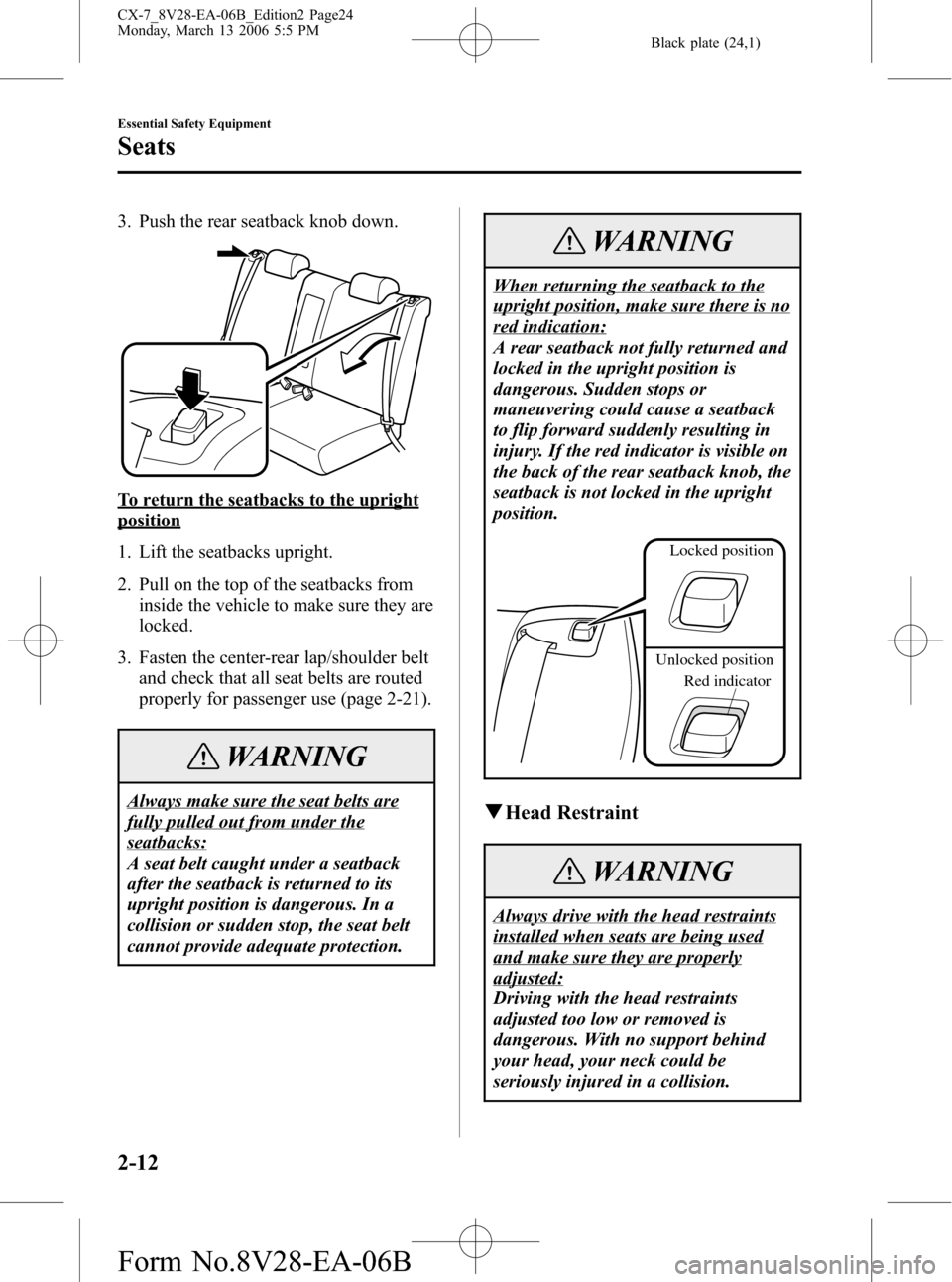
Black plate (24,1)
3. Push the rear seatback knob down.
To return the seatbacks to the upright
position
1. Lift the seatbacks upright.
2. Pull on the top of the seatbacks from
inside the vehicle to make sure they are
locked.
3. Fasten the center-rear lap/shoulder belt
and check that all seat belts are routed
properly for passenger use (page 2-21).
WARNING
Always make sure the seat belts are
fully pulled out from under the
seatbacks:
A seat belt caught under a seatback
after the seatback is returned to its
upright position is dangerous. In a
collision or sudden stop, the seat belt
cannot provide adequate protection.
WARNING
When returning the seatback to the
upright position, make sure there is no
red indication:
A rear seatback not fully returned and
locked in the upright position is
dangerous. Sudden stops or
maneuvering could cause a seatback
to flip forward suddenly resulting in
injury. If the red indicator is visible on
the back of the rear seatback knob, the
seatback is not locked in the upright
position.
Locked position
Unlocked position
Red indicator
qHead Restraint
WARNING
Always drive with the head restraints
installed when seats are being used
and make sure they are properly
adjusted:
Driving with the head restraints
adjusted too low or removed is
dangerous. With no support behind
your head, your neck could be
seriously injured in a collision.
2-12
Essential Safety Equipment
Seats
CX-7_8V28-EA-06B_Edition2 Page24
Monday, March 13 2006 5:5 PM
Form No.8V28-EA-06B
Page 25 of 406
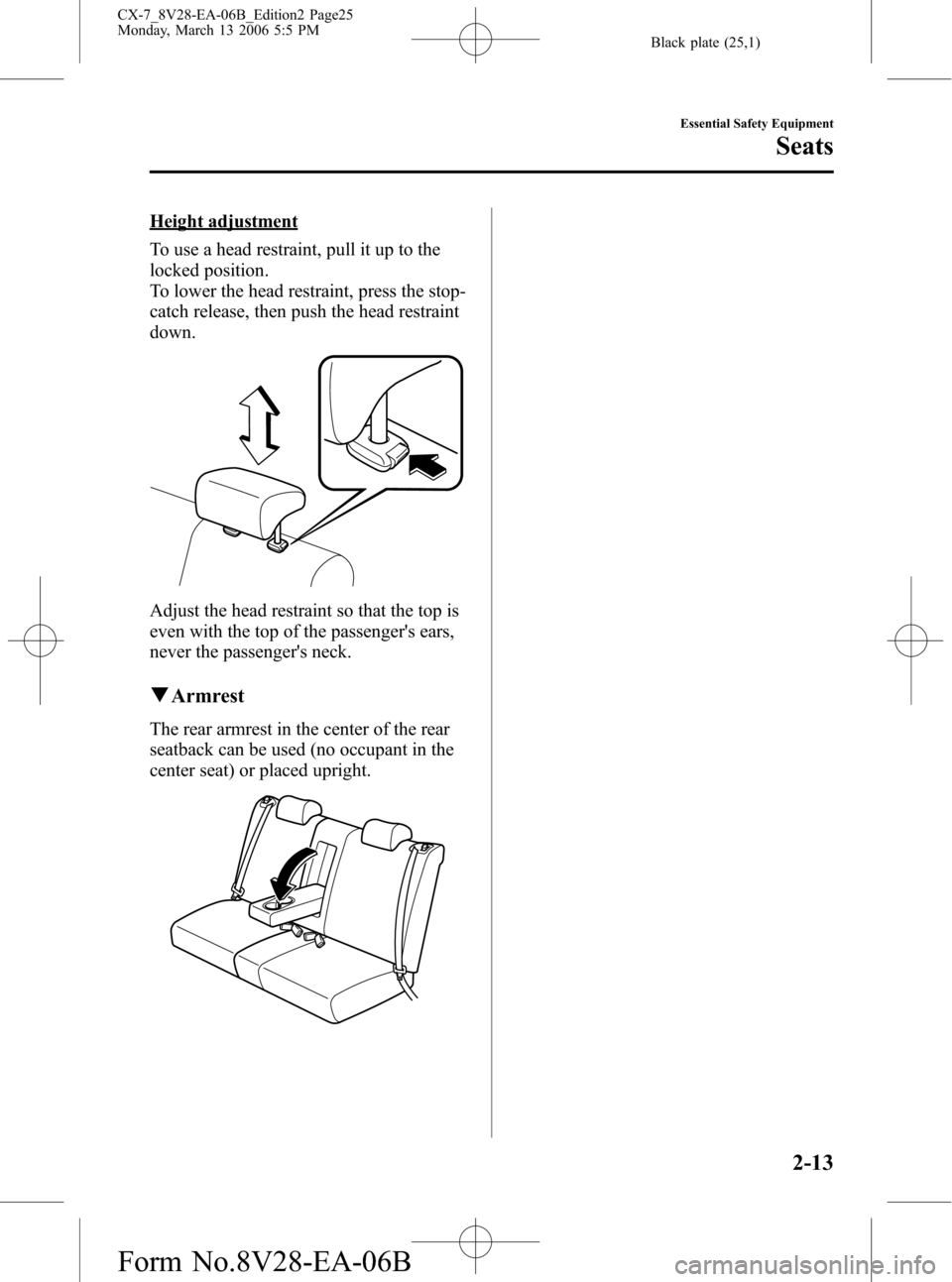
Black plate (25,1)
Height adjustment
To use a head restraint, pull it up to the
locked position.
To lower the head restraint, press the stop-
catch release, then push the head restraint
down.
Adjust the head restraint so that the top is
even with the top of the passenger's ears,
never the passenger's neck.
qArmrest
The rear armrest in the center of the rear
seatback can be used (no occupant in the
center seat) or placed upright.
Essential Safety Equipment
Seats
2-13
CX-7_8V28-EA-06B_Edition2 Page25
Monday, March 13 2006 5:5 PM
Form No.8V28-EA-06B
Page 26 of 406
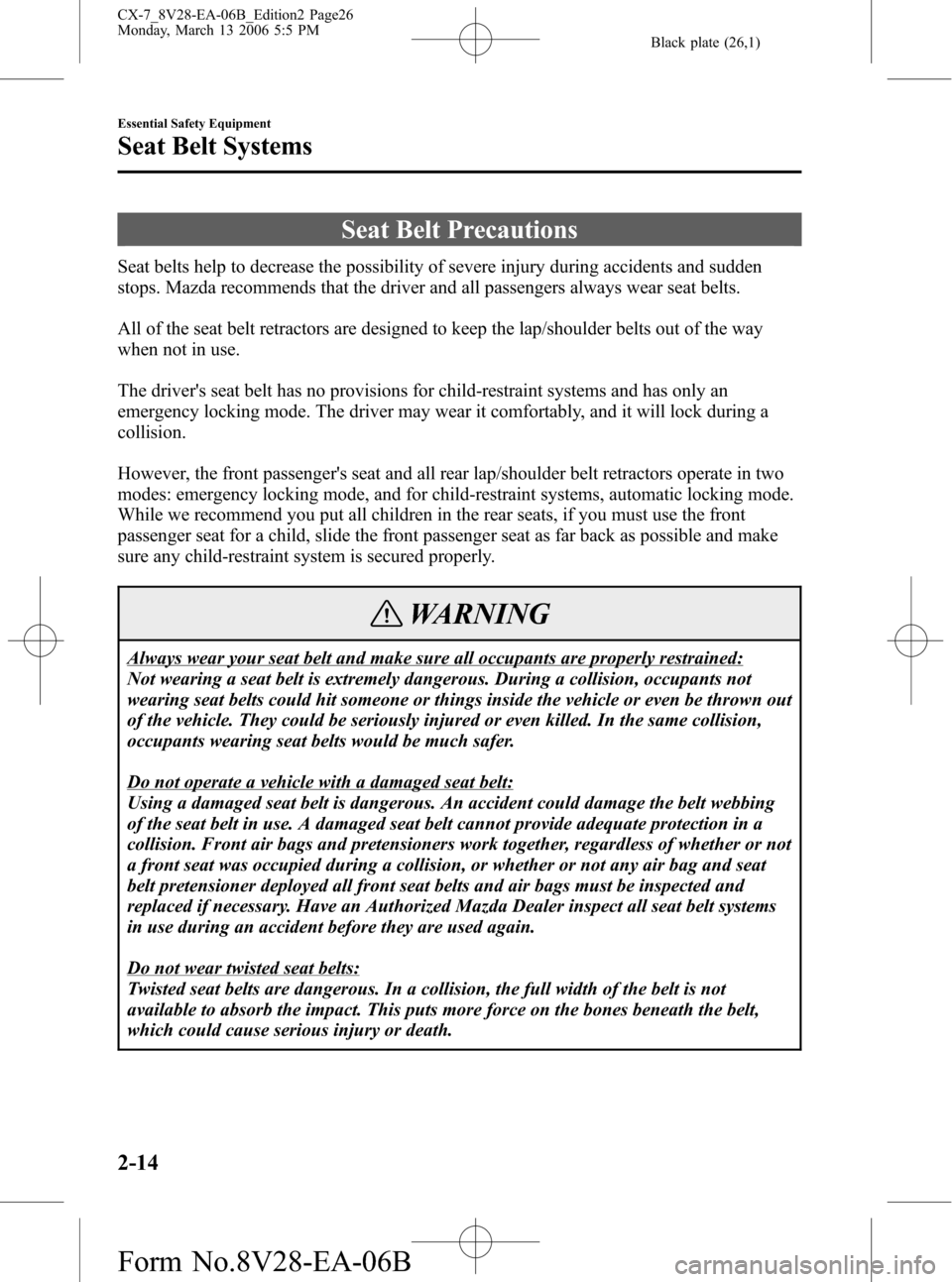
Black plate (26,1)
Seat Belt Precautions
Seat belts help to decrease the possibility of severe injury during accidents and sudden
stops. Mazda recommends that the driver and all passengers always wear seat belts.
All of the seat belt retractors are designed to keep the lap/shoulder belts out of the way
when not in use.
The driver's seat belt has no provisions for child-restraint systems and has only an
emergency locking mode. The driver may wear it comfortably, and it will lock during a
collision.
However, the front passenger's seat and all rear lap/shoulder belt retractors operate in two
modes: emergency locking mode, and for child-restraint systems, automatic locking mode.
While we recommend you put all children in the rear seats, if you must use the front
passenger seat for a child, slide the front passenger seat as far back as possible and make
sure any child-restraint system is secured properly.
WARNING
Always wear your seat belt and make sure all occupants are properly restrained:
Not wearing a seat belt is extremely dangerous. During a collision, occupants not
wearing seat belts could hit someone or things inside the vehicle or even be thrown out
of the vehicle. They could be seriously injured or even killed. In the same collision,
occupants wearing seat belts would be much safer.
Do not operate a vehicle with a damaged seat belt:
Using a damaged seat belt is dangerous. An accident could damage the belt webbing
of the seat belt in use. A damaged seat belt cannot provide adequate protection in a
collision. Front air bags and pretensioners work together, regardless of whether or not
a front seat was occupied during a collision, or whether or not any air bag and seat
belt pretensioner deployed all front seat belts and air bags must be inspected and
replaced if necessary. Have an Authorized Mazda Dealer inspect all seat belt systems
in use during an accident before they are used again.
Do not wear twisted seat belts:
Twisted seat belts are dangerous. In a collision, the full width of the belt is not
available to absorb the impact. This puts more force on the bones beneath the belt,
which could cause serious injury or death.
2-14
Essential Safety Equipment
Seat Belt Systems
CX-7_8V28-EA-06B_Edition2 Page26
Monday, March 13 2006 5:5 PM
Form No.8V28-EA-06B
Page 39 of 406
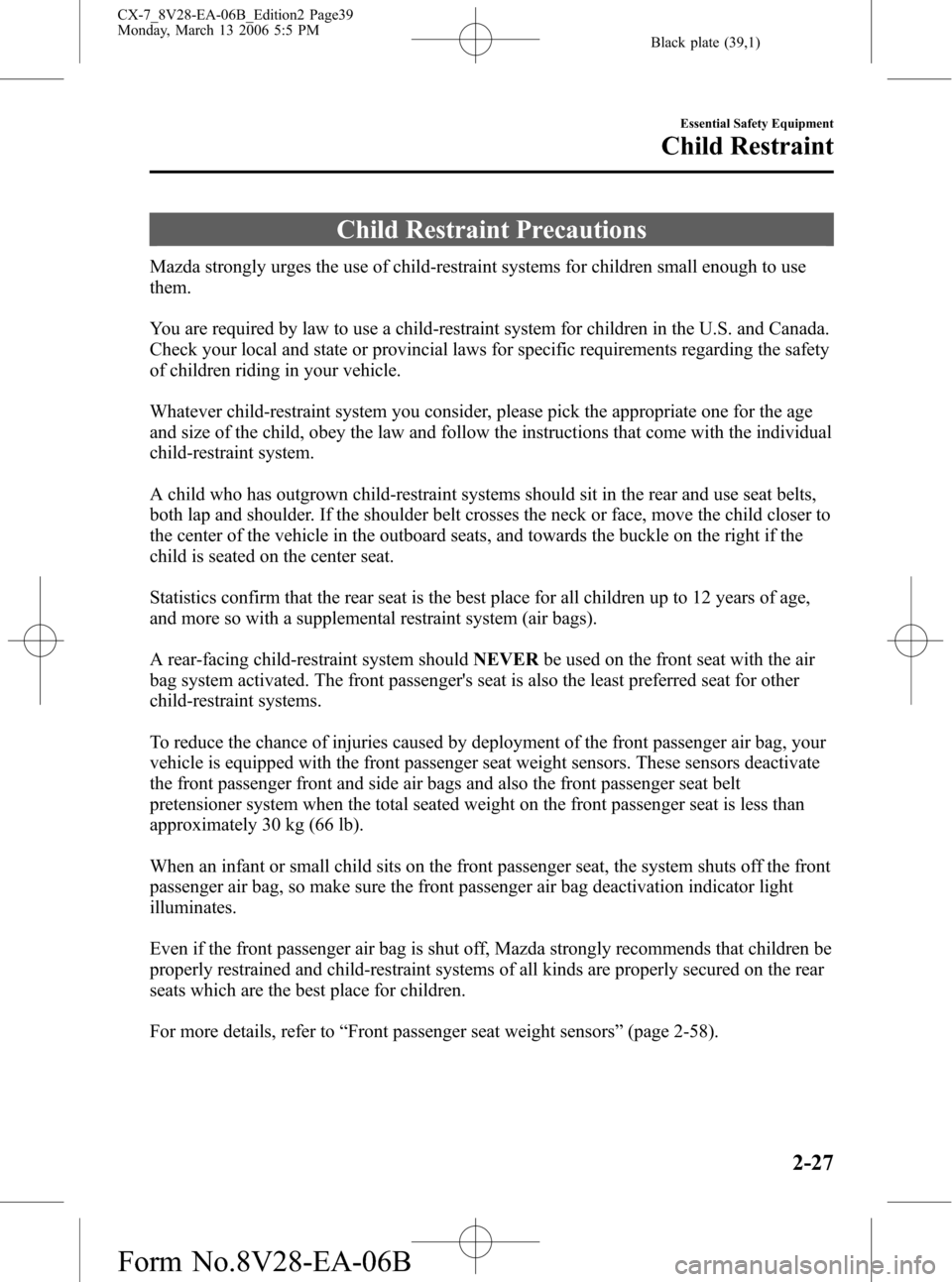
Black plate (39,1)
Child Restraint Precautions
Mazda strongly urges the use of child-restraint systems for children small enough to use
them.
You are required by law to use a child-restraint system for children in the U.S. and Canada.
Check your local and state or provincial laws for specific requirements regarding the safety
of children riding in your vehicle.
Whatever child-restraint system you consider, please pick the appropriate one for the age
and size of the child, obey the law and follow the instructions that come with the individual
child-restraint system.
A child who has outgrown child-restraint systems should sit in the rear and use seat belts,
both lap and shoulder. If the shoulder belt crosses the neck or face, move the child closer to
the center of the vehicle in the outboard seats, and towards the buckle on the right if the
child is seated on the center seat.
Statistics confirm that the rear seat is the best place for all children up to 12 years of age,
and more so with a supplemental restraint system (air bags).
A rear-facing child-restraint system shouldNEVERbe used on the front seat with the air
bag system activated. The front passenger's seat is also the least preferred seat for other
child-restraint systems.
To reduce the chance of injuries caused by deployment of the front passenger air bag, your
vehicle is equipped with the front passenger seat weight sensors. These sensors deactivate
the front passenger front and side air bags and also the front passenger seat belt
pretensioner system when the total seated weight on the front passenger seat is less than
approximately 30 kg (66 lb).
When an infant or small child sits on the front passenger seat, the system shuts off the front
passenger air bag, so make sure the front passenger air bag deactivation indicator light
illuminates.
Even if the front passenger air bag is shut off, Mazda strongly recommends that children be
properly restrained and child-restraint systems of all kinds are properly secured on the rear
seats which are the best place for children.
For more details, refer to“Front passenger seat weight sensors”(page 2-58).
Essential Safety Equipment
Child Restraint
2-27
CX-7_8V28-EA-06B_Edition2 Page39
Monday, March 13 2006 5:5 PM
Form No.8V28-EA-06B
Page 41 of 406

Black plate (41,1)
WARNING
Avoid putting a front-facing child-restraint system on the front passenger seat:
A front-facing child-restraint system should only be put on the front seat when it is
unavoidable. In a collision, the force of a deploying air bag could cause serious injury
or death to the child. Always move the seat as far back as possible.
Seating a child in a child-restraint system on the front passenger seat is dangerous:
Your vehicle is equipped with front passenger seat weight sensors. Even with front
passenger seat weight sensors, if you must use the front passenger seat to seat a child,
using a child-restraint system on the front passenger seat under the following
conditions increases the danger of the front passenger air bag deploying and could
result in serious injury or death to the child.
lThe total seated weight of the child with the child-restraint system on the front
passenger seat is approximately 30 kg (66 lb) or more with a child in the child-
restraint system.
lLuggage or other items are placed on the seat with the child in the child-restraint
system.
lA rear passenger or luggage pushing or pulling down on the front passenger
seatback.
lA rear passenger puts their feet on the front seat rails.lLuggage or other items are placed on the seatback or hung on the head restraint.lThe seat is washed.lLiquids are spilled on the seat.lThe front passenger seat is moved backward, pushing into luggage or other items
placed behind it.
lThe front passenger seatback contacts the rear seat.lLuggage or other items are placed between the front passenger seat and driver seat.lAny accessories increasing the total seated weight on the front passenger seat are
attached to the front passenger seat.
The designated positions with seat belts on the rear seats are the safest places for
children. Always use seat belts and child restraints.
Essential Safety Equipment
Child Restraint
2-29
CX-7_8V28-EA-06B_Edition2 Page41
Monday, March 13 2006 5:5 PM
Form No.8V28-EA-06B
Page 43 of 406

Black plate (43,1)
Installing Child-Restraint
Systems
Accident statistics reveal that a child is
safer in the rear seat. The front passenger's
seat is clearly the worst choice for any
child under 12, and with rear-facing child-
restraint systems it is clearly unsafe due to
air bags.
Some child-restraint systems now come
with tethers and therefore must be
installed on the seats that take tethers to
be effective. In your Mazda, tethered
child-restraint systems can only be
accommodated in the three positions on
the rear seat.
Even if your vehicle is equipped with
front passenger seat weight sensors (page
2-58), which automatically deactivates the
front passenger air bag, a rear seat is the
safest place for a child of any age or size.
Some child-restraint systems also employ
specially designed LATCH attachments;
refer to“LATCH Child-Restraint
Systems”(page 2-40).
WARNING
Tethered Child-Restraint Systems
Work Only on Tether-Equipped Rear
Seats:
Installation of a tether equipped child-
restraint system in the front
passenger's seat defeats the safety
design of the system and will result in
an increased chance of serious injury
if the child-restraint system goes
forward without benefit of being
tethered.
Place tether equipped child-restraint
systems where there are tether
anchors.
qRear Outboard Seat Child-
Restraint System Installation
Follow these instructions when using a
child-restraint system, unless you are
attaching a LATCH-equipped child-
restraint system to the rear LATCH lower
anchors. Refer to“LATCH Child-
Restraint Systems”(page 2-40).
NOTE
Follow the child-restraint system
manufacturer's instructions carefully. If
you are not sure whether you have a
LATCH system or tether, check in the
child-restraint system manufacturer's
instructions and follow them
accordingly. Depending on the type of
child-restraint system, it may not
employ seat belts which are in
automatic locking mode.
Essential Safety Equipment
Child Restraint
2-31
CX-7_8V28-EA-06B_Edition2 Page43
Monday, March 13 2006 5:5 PM
Form No.8V28-EA-06B
Page 49 of 406
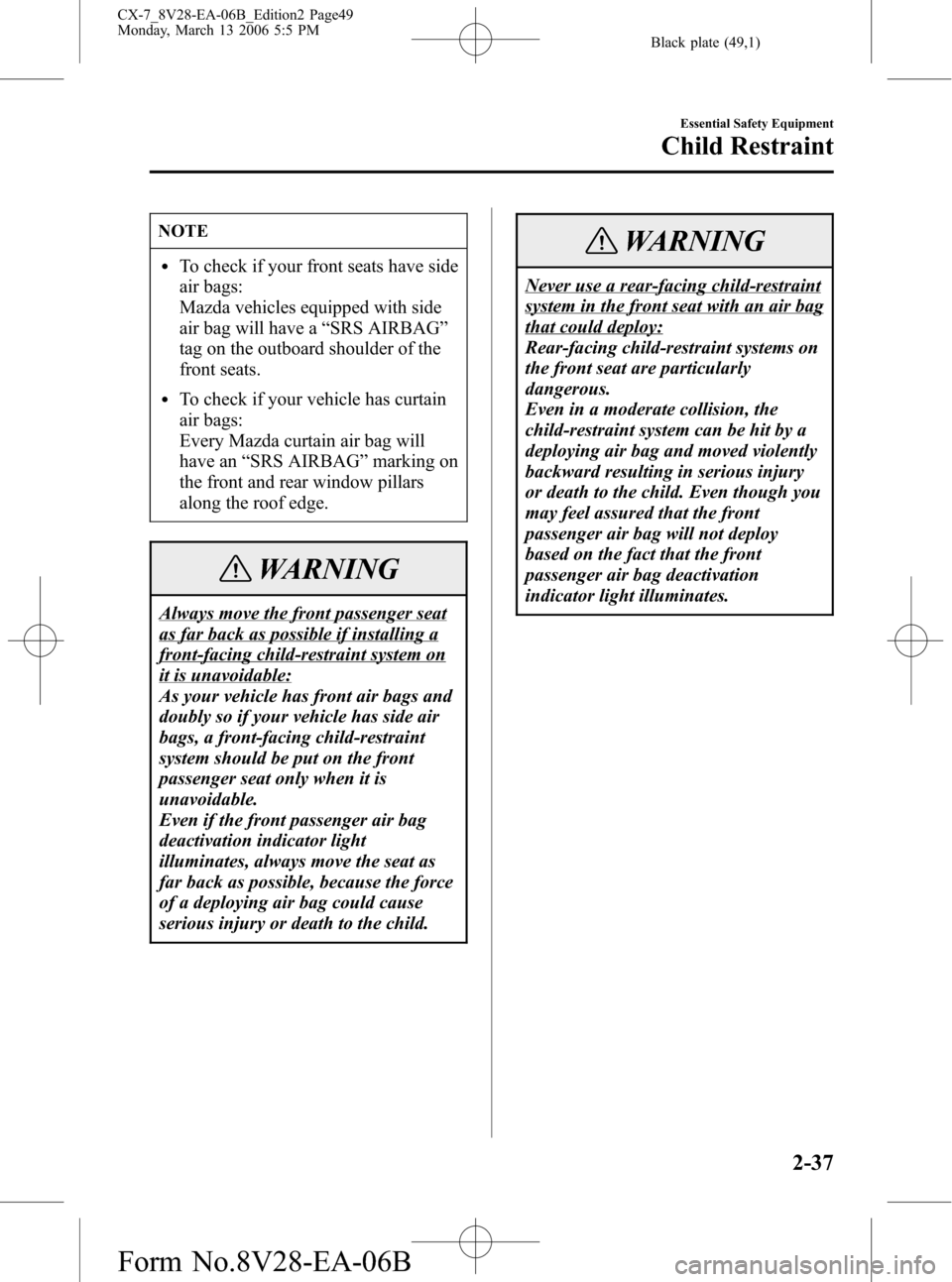
Black plate (49,1)
NOTE
lTo check if your front seats have side
air bags:
Mazda vehicles equipped with side
air bag will have a“SRS AIRBAG”
tag on the outboard shoulder of the
front seats.
lTo check if your vehicle has curtain
air bags:
Every Mazda curtain air bag will
have an“SRS AIRBAG”marking on
the front and rear window pillars
along the roof edge.
WARNING
Always move the front passenger seat
as far back as possible if installing a
front-facing child-restraint system on
it is unavoidable:
As your vehicle has front air bags and
doubly so if your vehicle has side air
bags, a front-facing child-restraint
system should be put on the front
passenger seat only when it is
unavoidable.
Even if the front passenger air bag
deactivation indicator light
illuminates, always move the seat as
far back as possible, because the force
of a deploying air bag could cause
serious injury or death to the child.
WARNING
Never use a rear-facing child-restraint
system in the front seat with an air bag
that could deploy:
Rear-facing child-restraint systems on
the front seat are particularly
dangerous.
Even in a moderate collision, the
child-restraint system can be hit by a
deploying air bag and moved violently
backward resulting in serious injury
or death to the child. Even though you
may feel assured that the front
passenger air bag will not deploy
based on the fact that the front
passenger air bag deactivation
indicator light illuminates.
Essential Safety Equipment
Child Restraint
2-37
CX-7_8V28-EA-06B_Edition2 Page49
Monday, March 13 2006 5:5 PM
Form No.8V28-EA-06B